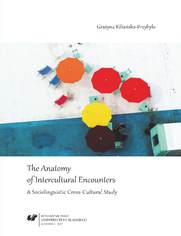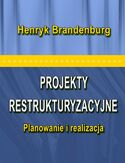The Anatomy of Intercultural Encounters. A Sociolinguistic Cross-Cultural Study - Onepress

ISBN: 978-8-3226-3017-4
stron: 248, Format: ebook
Data wydania: 2017-08-18
Ksińôgarnia: Onepress
Cena ksińÖŇľki: 16,84 zŇā (poprzednio: 20,79 zŇā)
Oszczńôdzasz: 19% (-3,95 zŇā)
ŇĽyjemy w czasach, w których kontakt z obcokrajowcami (osobisty lub wirtualny) jest nieunikniony. Publikacja koncentruje sińô na charakterystyce spotkaŇĄ mińôdzykulturowych, interakcji jakie zachodzńÖ pomińôdzy uczestnikami takich spotkaŇĄ oraz przedstawieniu czynników, które odgrywajńÖ istotnńÖ rolńô podczas komunikacji mińôdzykulturowej. Spotkania mińôdzykulturowe omówione sńÖ z dwóch perspektyw: teoretycznej i osobistej, uwzglńôdniajńÖcej doŇõwiadczenia studentów Filologii Angielskiej polskiego i tureckiego pochodzenia. Publikacja z jednej strony przybliŇľa specyfikńô kontaktów mińôdzykulturowych i pozwala zaobserwowańá mechanizmy, jakie podczas takich spotkaŇĄ wystńôpujńÖ; z drugiej zaŇõ stanowi materiaŇā ŇļródŇāowy w postaci osobistych refleksji uczestników badania, historyjek i anegdotek z zakresu komunikacji mińôdzykulturowej. Dlatego teŇľ, ksińÖŇľka adresowana jest do zarówno do studentów, osób podróŇľujńÖcych i majńÖcych kontakt z obcokrajowcami, jak i nauczycieli lub osób prowadzńÖcych szkolenia mińôdzykulturowe.
Osoby kt√≥re kupowaŇāy "The Anatomy of Intercultural Encounters. A Sociolinguistic Cross-Cultural Study", wybieraŇāy takŇľe:
- English 4 IT. Praktyczny kurs j 49,67 zŇā, (14,90 zŇā -70%)
- Ucz si 9,67 zŇā, (2,90 zŇā -70%)
- Zyskaj angielski akcent. Kurs video. Trening wymowy 99,00 zŇā, (39,60 zŇā -60%)
- English 4 IT. Praktyczny kurs j 59,00 zŇā, (26,55 zŇā -55%)
- ASAP. Jak nauczyńá sińô jńôzyka obcego tak szybko, jak to moŇľliwe 34,15 zŇā, (15,71 zŇā -54%)
Spis treŇõci
The Anatomy of Intercultural Encounters. A Sociolinguistic Cross-Cultural Study eBook -- spis treŇõci
Contents
Acknowledgments / 9
Introduction / 11
Chapter 1: Intercultural encounters / 17
1.1 Intercultural encounters – Facts / 17
1.2 Intercultural encounters as awareness-raising situations / 21
1.3 Intercultural encounters as interaction, mediation, and negotiation / 22
1.3.1 Intercultural encounters as mediation / 25
1.3.2 Intercultural encounters as negotiation / 26
1.4 Intercultural encounters – The linguistic dimension / 27
1.4.1 Intercultural encounters as language-in-action situations / 28
1.4.2 Intercultural encounters as culture bumps – Cross-cultural pragmatics / 30
1.5 Intercultural encounters as problem-solving tasks / 33
1.6 Intercultural encounters as emotion-generation situations / 34
1.6.1 Empathy / 37
1.6.2 Perspective-taking and sense-making / 38
1.6.3 Identity and self-construals / 39
1.6.4 Communication apprehension / 40
1.6.5 Willingness to communicate / 41
1.6.6 Self-disclosure / 42
1.6.7 Cultural differences in self-disclosure / 43
1.6.8 Stereotypes / 44
1.6.9 Culture shock / 45
1.7 The intercultural continuum / 46
1.7.1 Interculture, interlanguage / 47
1.7.2 Cultural intelligence / 48
1.7.3 Intercultural competence / 49
1.7.4 Intercultural sensitivity and other conditions for intercultural learning / 52
1.7.5 Learning – unlearning – relearning / 53
1.8 Obstacles to intercultural communication / 54
1.9 Intercultural encounter as a trigger for reflection / 56
1.9.1 Intercultural encounter as an example of experiential learning / 57
1.9.2 Intercultural encounter as a part of a sociocultural proces / 57
1.10 Research on intercultural competence / 58
1.10.1 Projects on intercultural competence and training – An overview / 58
1.10.2 Ways of studying intercultural competence / 59
Chapter 2: Narrative inquiry – Background / 61
2.1 Homo narrans and narrative intelligence / 62
2.2 Narrative’s moments – A record of one’s own experience (individual’s perspective) / 64
2.3 Tell me your story – Approaches to narrative analysis (researcher’s perspective) / 67
2.3.1 Narrative inquiry: The elements of a good story / 70
2.3.2 Cultural aspects in the narrative analysis / 72
2.4 Narrative and intercultural learning – The critical incident theory / 73
2.4.1 What is critical about critical incidents? / 74
2.4.2 Critical incidents and intercultural communication / 76
Chapter 3: The scheme of the research study / 81
3.1 Research objectives / 81
3.2 The subjects / 83
3.2.1 Poland and Turkey – Rationale for choosing the research partners / 86
3.3 Research tools and procedures / 88
3.3.1 Discussion-generating tasks / 88
3.3.2 The questionnaire for students / 89
3.3.3 Intercultural Sensitivity Scale / 90
3.3.4 Written narrative task: Narrative about intercultural encounters / 92
3.4 Narratives – Analysis and evaluation procedures / 93
3.4.1 Content analysis / 93
3.4.2 Statistical analysis: LIWC software – Brief characteristics / 93
3.5 Stages of the research project / 98
3.6 Data evaluation procedures / 101
Chapter 4: Narratives – Data presentation and analysis / 103
4.1. Statistical analysis of the narratives – General characteristics / 103
4.2 Content analysis of the encounters / 109
4.2.1 Topical analysis – Background about the nature of the encounters / 109
4.2.2 Intercultural encounter as an experience raising students’ language awareness / 114
4.2.3 Intercultural encounter as an opportunity to communicate / 118
4.2.4 Intercultural encounter as a lesson in culture / 123
4.2.5 Affectivity in intercultural encounters / 124
4.3 From “Haha” to “aha” – Intercultural encounters as an incentive to reflect, restructure, and learn from the experience / 126
4.3.1 Knowledge extension / 126
4.3.2 Self-knowledge / 128
4.3.3 Redefinition and modification of stereotypes / 129
4.3.4 Change of attitudes / 131
4.4 Intercultural encounters – Reflection for action – Teacher’s perspective / 133
4.5 Structural analysis / 137
Chapter 5: Questionnaires and scales – Data presentation and analysis / 139
5.1 Questionnaire – Background (biographical) information / 139
5.2 Intercultural profile – Data analysis / 147
5.3 The analysis of Cross-Cultural Adaptability Inventory (CCAI) / 163
5.3.1 Emotional Resilience / 163
5.3.2 Flexibility and Openness / 165
5.3.3 Perceptual Acuity / 167
5.3.4 Personal Autonomy / 169
Chapter 6: Conclusions / 173
6.1 Answers to the research objectives / 173
6.1.1 Differences between the groups of Polish P1, Polish P2, and the Turkish subjects / 173
6.1.2 The students’ perception and self-assessment of the sociocultural competence / 177
6.1.3 Culturally determined aspects of language use / 178
6.1.4 Communication and miscommunication / 179
6.1.5 Cultural sensitivity and cultural knowledge / 179
6.1.6 Intercultural encounters and affect / 180
6.1.7 Narrativisation and reflection / 183
6.1.8 Perspective-taking / 184
6.1.9 The students’ intercultural experiences and adaptability / 186
6.1.10 Learning outcomes: Me as a FL teacher vs. me as a language learner / 187
6.2 Evaluation of the research project / 192
6.3 Implications for further research / 193
Appendix / 197
1. Research scenario for intercultural encounters / 197
2. Iceberg Theory of Culture (supplementary materials implemented during the research – Theoretical training, Step 1) / 199
2a. The Iceberg Theory of Culture – Modified version – Theoretical training, Step 1) / 200
3. The Form technique (Supplementary materials implemented during the research – Theoretical training) / 201
4. Culture Quiz / 202
5. Questionnaire: Intercultural Encounters (Supplementary materials implemented during the research – Data collection procedure, Step 2) / 203
6. Narrative task (Supplementary materials implemented during the research – Data collection procedure, Step 3) / 207
7. LIWC2007 Output Variable Information – detailed data presentation: Polish P1 group, Polish P2 group, Turkish group / 208
Bibliography / 213
Streszczenie / 241
Zusammenfassung / 243





